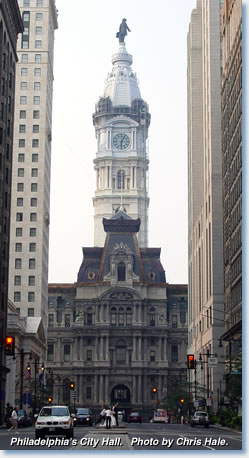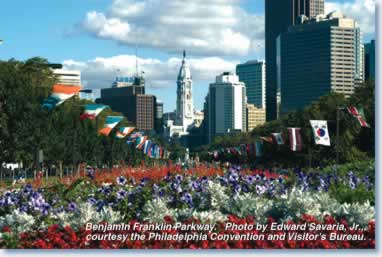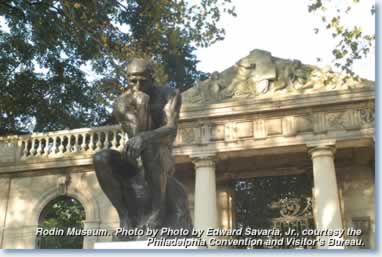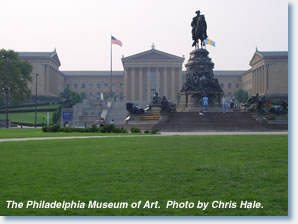 Philadelphia offers its guests a wealth of museums, civic landscapes, and sculpture within walking distance of the meeting hotels. Philadelphia's City Hall is at the intersection of Market and Broad Sts., just two blocks west of the Marriott and Loews. Built between 1871 and 1901 from the design of John McArthur Jr., this all-masonry building contains 700 rooms covering 14-and-a-half acres of floor space. Sculptor Alexander Milne Calder created over 250 figures for the building, from small faces observing you from dark corners to the statue of Pennsylvania's founder, William Penn, standing on the tower 584 feet above the city. You can tour the building and ride to the top of Penn's hat for an unforgettable panoramic view (215-686-2840, tours available Mon.–Fri.). Walk through the axial archway at Market St., go the center courtyard, and stand at the brass compass that marks the center of Penn's city.
Philadelphia offers its guests a wealth of museums, civic landscapes, and sculpture within walking distance of the meeting hotels. Philadelphia's City Hall is at the intersection of Market and Broad Sts., just two blocks west of the Marriott and Loews. Built between 1871 and 1901 from the design of John McArthur Jr., this all-masonry building contains 700 rooms covering 14-and-a-half acres of floor space. Sculptor Alexander Milne Calder created over 250 figures for the building, from small faces observing you from dark corners to the statue of Pennsylvania's founder, William Penn, standing on the tower 584 feet above the city. You can tour the building and ride to the top of Penn's hat for an unforgettable panoramic view (215-686-2840, tours available Mon.–Fri.). Walk through the axial archway at Market St., go the center courtyard, and stand at the brass compass that marks the center of Penn's city.
If you are a fan of American art, walk through the courtyard's northern archway to Broad Street. Proceed north along the west side for two blocks to the Pennsylvania Academy of the Fine Arts (PAFA) on the southwest corner of Broad and Cherry Sts. (215-972-7600). This art school and museum was founded by Charles Willson Peale in Indepen-dence Hall two centuries ago. Frank Furness and George W. Hewitt designed PAFA's present building, built in celebration of America's centennial. Works by American artists are exhibited throughout the lush Victorian interiors. There is an excellent gift shop and a café where you can warm up with light fare.
 The Benjamin Franklin Parkway, one of Philadelphia's important civic projects, begins just northwest of City Hall at 16th and Arch Sts. Planned in 1917 by Jacques Gréber and Paul Cret, the parkway slashes diagonally through the city's rectilinear, 17th-century grid plan. Cret and Gréber applied their École des Beaux Arts training to evoke the ambiance of a Parisian boulevard with multiple lanes divided by grassy, tree-filled medians, and edged with important buildings. The parkway is an outdoor sculpture garden with monumental architecture. Even in January, without the plantings in bloom and the fountains in operation, walking along the parkway is a wonderful introduction to Philadelphia. Here are just a few highlights.
The Benjamin Franklin Parkway, one of Philadelphia's important civic projects, begins just northwest of City Hall at 16th and Arch Sts. Planned in 1917 by Jacques Gréber and Paul Cret, the parkway slashes diagonally through the city's rectilinear, 17th-century grid plan. Cret and Gréber applied their École des Beaux Arts training to evoke the ambiance of a Parisian boulevard with multiple lanes divided by grassy, tree-filled medians, and edged with important buildings. The parkway is an outdoor sculpture garden with monumental architecture. Even in January, without the plantings in bloom and the fountains in operation, walking along the parkway is a wonderful introduction to Philadelphia. Here are just a few highlights.
The Cathedral of Saints Peter and Paul (1846–64) anchors the southeast end of the Parkway at 18th and Race Streets. John Notman designed the exterior of the basilica with John T. Mahoney and Napoleon LeBrun. Logan Square, directly across from the cathedral, is one of the five squares in William Penn's original plan for the city. The square was once the site of public executions; today, the Swann Memorial Fountain by Alexander Sterling Calder (1924) occupies the center. The fountain's reclining bronze allegorical figures represent the city's three major waterways, the Delaware and Schuylkill Rivers and the Wissahickon Creek.
North of the fountain at 19th and Vine Streets is the central branch of the Free Library of Philadelphia (1927). The library's extensive collections include rare books, theater materials, orchestral music, and children's literature. There is always an exhibit in the entry hall and a gift shop as well as an excellent cafeteria on the top floor (215-686-5322). The companion building east of the library is the Philadelphia Family Court.
On the south side of Logan Square, at 19th Street, is the Academy of Natural Sciences (215-299-1000). Founded in 1812, during an era when natural history was developing into the biological sciences, the academy is the steward of such significant field collections as the herbarium from the Lewis and Clark expedition and the specimens of John James Audubon. In addition to a flourishing research program, there is a full schedule of public exhibitions. At the opposite end of the block, Moore College of Art and Design, the nation's first visual art school for women, has galleries open to the public (215-568-4515).
As you walk west, you'll see the two pylons on the parkway's medians at 20th Street, the Civil War Soldiers and Sailors Memorial (1921) by Herman Athers MacNeil. The imposing building on the southwest corner of the intersection is The Franklin Institute (215-448-1200). In the building's rotunda is the Benjamin Franklin National Memorial, a colossal 21-foot statue of the statesman-scientist by James Earle Fraser (1938). There are also some exhibits of Franklin-related materials.
 Cross the parkway at 22nd Street to see Gréber and Cret's Rodin Museum (215-763-8100). Within this jewel box of a building is the largest collection of the sculptor's works outside of France. See Gates of Hell, The Thinker, and The Burghers of Calais and enjoy the enclosure of the surrounding walled garden.
Cross the parkway at 22nd Street to see Gréber and Cret's Rodin Museum (215-763-8100). Within this jewel box of a building is the largest collection of the sculptor's works outside of France. See Gates of Hell, The Thinker, and The Burghers of Calais and enjoy the enclosure of the surrounding walled garden.
Continue walking west. You'll have the opportunity to see Rudolf Siemering's Washington Monument (1897) in the middle of the traffic circle in front of the Philadelphia Museum of Art (PMA). Commissioned by the Society of Cincinnati of Pennsylvania, the monument celebrates Washington on three levels—the hero, his era, and his country—and connects the levels with flowing water during warm weather. On a grassy plot northwest of the fountain, Emmanuel Fremiet's gilded Joan of Arc (1890) greets visitors seated atop her horse, dressed in armor, carrying a banner.
 The Philadelphia Museum of Art at 26th Street is the northwest terminus of the parkway (215-763-8100). Horace Trumbauer's three-part Greek temple (1919–28) sits atop Fairmount, the site of the city's former reservoir. You will find major collections of fine arts from Romanesque to contemporary, an excellent bookstore, a cafeteria, and a gift shop. PMA has evening hours with many special programs. If you prefer not to walk back to the convention hotels, there are convenient buses at the west entrance of the building. From the west doorway, look up the east bank of the Schuylkill River and see the Fairmount Water Works, designed by Frederick Graff and Son (1815). This was the country's first large-scale public water project. You can tour the neo-classical structures and see the turbine engine and exhibits.
The Philadelphia Museum of Art at 26th Street is the northwest terminus of the parkway (215-763-8100). Horace Trumbauer's three-part Greek temple (1919–28) sits atop Fairmount, the site of the city's former reservoir. You will find major collections of fine arts from Romanesque to contemporary, an excellent bookstore, a cafeteria, and a gift shop. PMA has evening hours with many special programs. If you prefer not to walk back to the convention hotels, there are convenient buses at the west entrance of the building. From the west doorway, look up the east bank of the Schuylkill River and see the Fairmount Water Works, designed by Frederick Graff and Son (1815). This was the country's first large-scale public water project. You can tour the neo-classical structures and see the turbine engine and exhibits.
Far across the Schuylkill, the University of Pennsylvania Museum of Archeology and Anthropology at 33rd and Spruce Streets houses collections from throughout the world. Galleries devoted to ancient Greece, Egypt, Mesopotamia, Asia, and Mesoamerica display a small fraction of the museum's enormous wealth. Along with the British Museum's, Penn's Mesopotamian collections are unrivalled outside of the Middle East. Wilson Eyre Jr., Frank Miles Day, and Cope and Stewardson (1893–1928) designed the original portion of the building. Mitchell Giurgula's addition houses support areas such as a cafeteria and lecture halls. Visit the galleries, buy a book in the imaginative gift shop, and enjoy it while having a cup of tea (215-898-4001).
This abbreviated list of Philadelphia's riches would be remiss without a word about the Barnes Foundation. A century ago, patent medicine manufacturer Albert Barnes amassed a visionary collection of Impressionist art when it sold for bargain prices. The Barnes collection is displayed in a Paul Cret building situated in a magnificent arboretum in Merion, just across the city line. It is well worth the 15-minute train ride from the SEPTA train station in Market East or the 44 Bus to Merion. Check www.barnesfoundation.org for detailed directions and the required two-week advance reservations. The intimacy of the exhibition is seldom matched. Dr. Barnes's exhibit designs highlight the cultural connections he perceived in his collections. You'll see exceptional paintings displayed next to Pennsylvania German wrought iron and African masks. But hurry! Plans are underway to move the Barnes collection to a new building on the parkway.
—Doris Devine Fanelli is the chief of the Division of Cultural Resources Management at Independence National Historical Park and a member of the Local Arrangements Committee.
Tags: Annual Meeting
Comment
Please read our commenting and letters policy before submitting.






